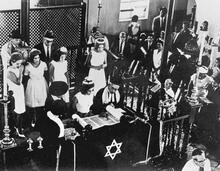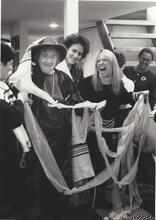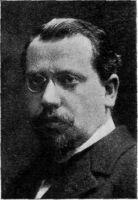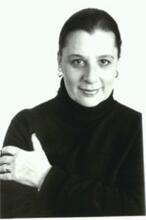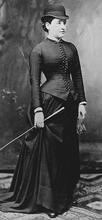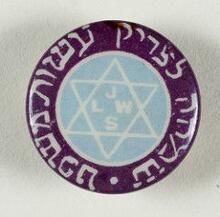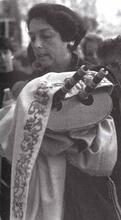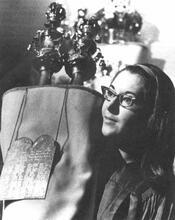Partnership Minyan
The Partnership Minyan is an Orthodox feminist prayer service that seeks to maximize women’s involvement in prayers while adhering to Jewish law, or halakha. This entails placing the bima (podium) in the middle and allowing women to lead select sections, although women do not count as part of the quorum of ten men. The first two partnership minyanim opened simultaneously in 2002 (Shira Hadasha in Jerusalem and Darkhei Noam in New York), and today there are over 80 around the world. Some have joined an informal network of “Independent Minyanim” that includes both Orthodox and non-Orthodox services seeking women’s inclusion, marking the first time in modern American Jewish history when Orthodox and non-Orthodox synagogues united under one umbrella as part of one movement.
Background: Patriarchy in Orthodox synagogues
The Orthodox movement emerged in the nineteenth century in response to the perceived threat to Jewish tradition of the Reform Movement and the Enlightenment. The first Orthodox synagogues were built in large part with the express purpose of keeping women out of the sanctuary (Sarna, 1987). Since then, almost all Orthodox synagogues have been constructed with sections set apart for women (behind a curtain, on the other side of a partition, up on the balcony, or in more extreme cases in a separate room)—if indeed room was allotted for women at all. The men’s section is where the podium (the The Day of Atonement, which falls on the 10th day of the Hebrew month of Tishrei and is devoted to prayer and fasting.bimah) stands, the Holy Ark is placed, and the Torah circulates. All ritual activity emerges from the men’s section, as does non-ritual activity such as announcements, sermons, and appeals.
In the ancient Temple, no gender segregation existed, other than one day a year, Simchat Beit Hashoeva, in which men were sent to the “Women’s Gallery” (Grossman 1992). Although Jewish synagogues have been used since before the Second Temple period, none of the ancient synagogues unearthed in Israel have women’s sections, and scholars have concluded that ancient synagogues included women’s side-by-side participation with men (Hachlili 2013). Similarly, the Talmud, compiled five centuries after the destruction of the Second Temple, does not allude to partitions in synagogues (Safrai 1992).
The architecture of the Orthodox synagogue in the modern era, which physically separates women and men, is only part of the system of women’s exclusion in Orthodox prayer. The placement of women outside the main activity of the sanctuary means that women cannot lead the services and men sometimes have difficulty hearing women’s voices. These practices reinforce the exclusion of women from the prayer quorum (The quorum, traditionally of ten adult males over the age of thirteen, required for public synagogue service and several other religious ceremonies.minyan) and the assertion that women’s voices are sexually sinful (kol isha erva).
Contemporary Orthodox women describe the impact of these practices on them. The blogger “Tamar,” after finding that the women’s section of her own synagogue was filled with garbage, wrote, “There is a metaphor here, and it is not even remotely subtle. Women are trash. Trash belongs where the women usually go. Wow. Thanks.” The late Orthodox feminist activist Rivka Haut similarly wrote:
Women in Orthodox synagogues cannot be heard, either as individuals, or as a group. They cannot perform any ritual act in that setting – they do not even open the ark, an act that requires neither speaking nor being called by name. They are able to pray along with the congregation and to hear the Torah reading, but they remain private participants, like playgoers who, although absorbed in the action and perhaps even singing along with the music, allow the actors to direct the activity….. While many, perhaps even most, religious women are satisfied with the private role assigned to them in the traditional synagogue, an increasing number are finding this situation intolerable. (Aranoff 1992)
Earlier resistance: Women’s prayer groups
The American feminist movement of the 1970s raised many Orthodox women’s awareness of their own synagogue exclusion, bringing about one of the first practical innovations for women in modern Orthodox Judaism and a crucial pre-cursor to the partnership minyan: the women’s prayer group. The first women’s prayer group took place at Lincoln Square Synagogue in New York in the late 1960s on the holiday of Lit. "rejoicing of the Torah." Holiday held on the final day of Sukkot to celebrate the completing (and recommencing) of the annual cycle of the reading of the Torah (Pentateuch), which is divided into portions one of which is read every Sabbath throughout the year.Simhat Torah in response to the practice of not circulating the Torah scroll in the women’s section (Prell 2007, 308). Monthly women’s prayer groups spread during the 1970s, especially around the New York area but also in several cities in the Midwest, and became the backbone of the Orthodox feminist movement. In 1985, a group of Yeshiva University faculty published a Halakhic decisions written by rabbinic authories in response to questions posed to them.responsum officially prohibiting women’s prayer groups; this gave the women’s groups considerable public attention and led to a spike in their numbers (Haut 1992, Kohler 1985, Mandel 1997, Monson 1992).
Many women describe their experiences in women’s prayer groups as formative. Susan Aranoff, one of the most vocal advocates on behalf of Woman who cannot remarry, either because her husband cannot or will not give her a divorce (get) or because, in his absence, it is unknown whether he is still alive.agunot, wrote a 1992 essay about the experience of lifting a Torah scroll at her first Shabbat prayer service with a women’s prayer group: “Awe mixed with pleasure, a high voltage current passing through me, binding my hands with magnetic force to the etzeihayyim of the Torah, my heart pounding with the thrill and apprehension of holding the Torah securely; these were the feelings that flowed through me as I lifted the Torah to the sound of the familiar melody” (Aranoff 1992).
The women’s prayer groups enabled women to participate in a familiar Orthodox service without violating any of the practices of women’s exclusion in the synagogue (Onishi 1997). They are a form of social change that takes place outside of the sanctuary, creating a space for women to practice while leaving Orthodox norms in place. As sociologist Ailene Cohen Nusbacher found, these prayer groups often revolved around private religious desires, “a spiritual search for meaningful, quiet and serious prayer; a feeling of community, a connection to God, and a desire to celebrate rites of passage.” The women participating in these groups are expressing a desire to be more religious, to be, as Nusbacher describes, “closer to G‐d” (Nusbacher 1999, 2000).
Women’s prayer groups, then, were a vital precursor to the Partnership Minyan in encouraging women to challenge their own exclusion from Orthodox prayer, creating an empowering “safe space” for women outside the sanctuary, and providing skills and visceral experiences in active prayer participation. But they did so without impacting what occurs in the standard Orthodox synagogue itself. Moreover, in women’s prayer groups women do not count as a quorum, and thus do not recite parts of the service that are considered “divrei kedusha,” or “holy bits,” such as Lit. (Aramaic) "holy." Doxology, mostly in Aramaic, recited at the close of sections of the prayer service. The mourner's Kaddish is recited at prescribed times by one who has lost an immediate family member. The prayer traditionally requires the presence of ten adult males.kaddish, blessings on the Torah, or the repetition of the Lit. "standing." The primary element of each of the three daily prayer services.Amidah. Even a hundred women praying together in this setting are not considered a halakhic community.
The Partnership Minyan
As feminist conversations evolved, it was perhaps only a matter of time before Orthodox feminists decided they needed more. Orthodox feminists debated these issues for many years, negotiating a delicate dance of movement towards change and desire to remain “within” their traditional communities, institutions, and practices.
For several years, a variety of groups of men and women—precursors to the Partnership Minyan—quietly and privately made changes. A group called the Leader Minyan, in which women read from the Torah and led parts of the service, met monthly in Jerusalem. A handful of communities, such as at Pardes and Yedidya in Jerusalem, as well as small groups elsewhere in private homes, experimented with allowing women to lead Friday night Kabbalat Shabbat (Friday night psalms).
Then, in 2002, Orthodox feminists in two locations, unbeknownst to each other, decided to make more public steps towards communal change. The new Orthodox congregations they created—Darkhei Noam in New York and Shira Hadasha in Jerusalem (started by Orthodox feminist scholar Dr. Tova Hartman)—are based on a new model for women’s inclusion that seeks to make changes within communities of both women and men without sending women to a separate room, while maximizing women’s participation in services without violating the perceived letter of the halakhic law.
These communities enhance women’s participation in four main ways:
- Moving the partition. They change the shape of the sanctuary to be more egalitarian without removing the partition entirely, so that women and men sit side by side.
- Placing the bimah in the middle. They place the bimah in the center under the partition so that people can access it from both sides of the partition.
- Women leading certain parts of services. Women are allowed—and in some cases invited—to lead the parts of the services that are not considered to need a minyan (that is, parts that do not have “holy bits,” so that historically even boys under the age of Lit. "son of the commandment." A boy who has reached legal-religious maturity and is now obligated to fulfill the commandmentsbar mitzvah could fulfill those roles). The parts of the service that women can recite include:
- Kabbalat Shabbat
- The blessings upon awakening
- Pesukei D’zimra (Psalms)
- Torah chanting and Haftara chanting
- Blessings on the Torah chanting (except the first two, Cohen and Levi) and on Haftara chanting (aliyot)
- Blessings for the State of Israel, for the sick, etc. (Mi Sh’berach)
- Blessings on the New Moon
- Removing and replacing the Torah in the Ark
- End-of-service passages (An’im Zemirot, Aleinu, etc.)
- Women taking other leadership roles. Women are allowed to take on non-ritualistic roles as well, such as giving a sermon and serving as synagogue president.
Immediately following the opening of these two congregations—which shortly thereafter were dubbed “Partnership Minyan” in the Orthodox feminist community (Trachtman 2010)—the model sprouted new synagogues around the world, including in North America, Europe, Israel, and Australia. As these minyanim grew and spread, new customs evolved, such as women saying Hallel (the special prayer recited on holidays and the New Moon), women leading Friday night Ma’ariv (evening service), women blowing the Ram's horn blown during the month before and the two days of Rosh Ha-Shanah, and at the conclusion of Yom Kippur. shofar, or women reciting Kol Nidrei or Selichot (prayers of penitence) during the High Holidays.
Although there are some minor divergences between congregations—some wait for ten women before starting services, in addition to the traditional quorum of ten men; some do not allow women to recite Ma’ariv or Hallel; some use the word “Orthodox” to define themselves and some prefer “halakhic”—most of the core practices are consistent among the communities, even ones as distant from each other as Melbourne, Australia, and New York City. In addition, many partnership minyanim stand independently of communal rabbinic establishment. Most do not have official rabbis on staff, and some, such as Darkhei Noam in New York, Darchei Noam in Modi’in, and Shira Hadasha in Jerusalem, have compiled their own lists of halakhic resources .
By 2008, 22 partnership minyanim existed. By 2020, there were at least 83 in five countries, with new groups popping up all the time. An informal survey in 2020 listed 44 partnership minyanim in Israel, spread from North to South, with many in Jerusalem, Modi’in, and Be’er Sheva. According to the Jewish Orthodox Feminist Alliance, there are 31 in America, two in Australia, one in Canada, and five in the United Kingdom. These numbers are not exact, because no official network or umbrella organization joins these groups. Several small conferences have been dedicated to exploring the phenomenon, and a Hebrew Facebook page exists, but it is not a movement or a denomination, nor are the congregations connected in any formal way. No official rules come from an overarching body, as in most denominations. Rather, each group emerges on its own from the grass roots. Groups form all the time, and without a central mechanism for tracking these formations, the information remains incomplete.
Orthodox responses to the Partnership Minyan
From the beginning, the model of the Partnership Minyan attracted both support and opposition from the Orthodox establishment. Halakhic arguments in favor began in the late 1990s, when Mendel Shapiro, a Jerusalem lawyer and non-practicing Orthodox rabbi, wrote an article about the halakhah of women and Torah reading, which became the legalistic blueprint for Shira Hadasha. Shapiro’s article—which was widely and excitedly circulated in the Orthodox feminist community before being published in the Edah Journal—challenged the most basic gender assumptions of Orthodox worship and paved the way for the events that followed (Shapiro 2001). His rationale revolved around a passage in the Babylonian Talmud (Megillah 23a) that reads: “All may be numbered among the seven [who are called to the Torah on Shabbat], even a minor and even a woman, but the Sages said: a woman is not to read from the Torah on account kevod ha-tsibur, dignity of the congregation.” Shapiro, arguing that there is no essential halakhic opposition to women’s leading parts of the service, worked to break not halakhah per se but rather Orthodox communal taboos.
When Shapiro’s article was published in 2001, it appeared alongside an article opposing the partnership model. While written by an Orthodox rabbi, Yehuda Henkin, it rests not on any essential halakhic opposition but rather on an unabashedly sociological argument: “[W]omen’s aliyot remain outside the consensus, and a congregation that institutes them is not Orthodox in name and will not long remain Orthodox in practice. In my judgment, this is an accurate statement now and for the foreseeable future, and I see no point in arguing about it” (Trachtman 2010).
Rabbinic scholar Rabbi Dr. Daniel Sperber responded with a more elaborate halakhic justification for the partnership model; as a result, he became the spiritual adviser for many partnership communities around the world—and was publicly shamed by some Orthodox rabbis for daring to support women’s inclusion (Sperber 2002). Sperber contended that some rabbis were against women’s participation not because of halakhah per se, “but rather a sense of ingrained conservatism, naturally suspicious of change…. It upsets the received religious order,….the prevailing attitude in the Orthodox community that refuses to tolerate innovative practices simply because they fail to conform to social convention.” He concluded that “in those communities where it is agreed that change within the normative halakhic framework should take place and that the absence of such change will be a source of pain and suffering to an important segment of the community, the principle of kevod ha-beriyot [human dignity] overcomes the stated principle of kevod ha-tsibur [congregational dignity" (Sztokman 2011; 21).
Orthodox feminist professor of Jewish philosophy Tamar Ross has expanded on Rabbi Sperber’s approach, arguing that women’s inclusion is not only permissible, it is the embodiment of Torah values. “Our understanding of the meaning of these texts is inevitably affected by the context in which they are read, so that greater attention to the newfound moral sensibilities with regard to women need not be regarded with suspicion; to the contrary, it bears promise of enriching our understanding of Torah” (Trachtman 2010, 23).
Although many Orthodox rabbis have opposed the partnership model over the years—deriding it as against halakhah because it is “radical feminism,” calling it “an innovation too far,” or describing it as “Reform in the name of halakhah”—most partnership minyanim have continued undeterred (Trachtman 2010). In some smaller communities, however, the partnership minyan has had to close due to rabbinic and communal pressure.
The complicated response to the partnership minyan can be seen in the experiences of Michal and Elitzur Bar-Asher Siegal. In 2008, Michal, then a doctoral student in religion at Yale University, and her husband Elitzur, then a doctoral student in linguistics at Harvard University, were influential in starting a partnership synagogue in New Haven, Connecticut. The opposition was quick to come. Elitzur faced the threat of excommunication by local rabbis, which meant that for a time he was not allowed to be called up to the Torah in some other local synagogues. Approaching one of the rabbis who called for his excommunication, he called for an open discussion, which led to a public discussion about halakhah. The opposition eventually waned and the New Haven partnership synagogue strengthened and grew. The couple traveled around the United States as halakhic advisors for partnership minyanim and co-published a pamphlet, “A Guide to the Halakhic Minyanim,” in Hebrew and English, the first halakhic guidebook for partnership synagogues. After they completed their doctorates, they moved to Israel and became active in a partnership minyan there.
Societal Impact
Interestingly, the minyanim are not evenly dispersed but rather clustered in certain regions. Many exist in places like New York and Jerusalem, and yet they are completely absent elsewhere, even in places with large Jewish populations, such as Florida. Many college campuses are home to partnership minyanim.
Recently, a new grass-roots movement has developed of “Independent Minyanim” that do not officially belong to any of the traditional movements. An online, informal list of independent minyanim includes egalitarian-oriented groups both with and without a partition and some counting women for a quorum. This is the first time Orthodox and non-Orthodox synagogues are grouped together under one umbrella—that is, the Partnership Minyanim, which for the most part consider themselves Orthodox, are clustered with other congregations as part of a movement to redefine denominational boundaries and identify a grass-roots communal drive for halakhically based, gender-sensitive, free-thinking communities that are not bound by top-down conventions or customs that seem archaic and unnecessary. This trend could signal the creation of a new movement that exists in the seams between Orthodoxy and Conservative Judaism, a movement on the margins that is changing the way Jewish communities define themselves
According to William Kaplowitz, who researched the sprawl of partnership minyanim for his master’s thesis, the partnership minyan is a culture that is transferred from place to place one person at a time as a result of individuals’ powerful need to have this cultural option where they live. In other words, the model is a reflection of committed individuals’—both women and men—vital role in establishing, sustaining, and transporting the culture (Kaplowitz 2008).
Interviews with over fifty men who participate in partnership minyanim reveal that men are often the movers and shakers behind the establishment of these synagogues—sometimes for feminist motives, but often out of other personal motives and desires to see change in Orthodox norms and practices not only for women but for the socialization into masculinity (Sztokman 2011).
Over the years, many people have written about the powerful impact of their participation in these minyanim, whether they join out of feminist ideology, other motives, or by accident. British Orthodox feminist Sally Berkovic writes that “Partnership minyanim allow young girls to see a different kind of modelling about Jewish ritual life and their right to claim public space” (2019). An Israeli woman described accidentally coming to a place where she heard a woman lead services for the first time, and “shaking with excitement” (Chomsky 2014).
Aranoff, Susan B. “On being a hazzanit.” In Daughters of the King: Women and the Synagogue, edited by Susan Grossman and Rivka Haut, 261‐264. Philadelphia: Jewish Publication Society, 1992.
Bar-Asher Siegal, Elitzur A. and Michal. Guide for the “Halachic Minyan.”. Shvat 5768, 2008 https://static.squarespace.com/static/50286482c4aad3000d9020e7/51ee3f7ee4b02f53b40f2c15/51ee3f7ee4b02f53b40f2c19/1322226477717/bar-asher-siegal-guide-for-the-halachic-minyan.pdf.
Berkovic, Sally. Under my hat: How Orthodox Jewish women are shaping the Jewish future. New Jersey: Ktav, 2019.
Chomsky, Gilit. “Something new is starting: A hazzanit in my synagogue.” Ynet, March 27, 2014 (Hebrew). https://www.ynet.co.il/articles/0,7340,L-4504163,00.html
Grossman, Susan. “Women in the Jerusalem Temple.” In Daughters of the King: Women and the Synagogue, edited by Susan Grossman and Rivka Haut, 15-38. Philadelphia: Jewish Publication Society, 1992.
Grossman, Susan and Rivka Haut, eds. Daughters of the King: Women and the Synagogue, Philadelphia: Jewish Publication Society, 1992.
Hachlili, Rachel. Ancient Synagogues - Archaeology and Art: New Discoveries and Current Research. The Netherlands: Koninklijke: Brill NV Leiden, 2013.
Haut, Rivka. “Women’s prayer groups and the Orthodox synagogue.” In Daughters of the King: Women and the Synagogue, edited by Susan Grossman and Rivka Haut, 138‐139. Philadelphia: Jewish Publication Society, 1992.
Kaplowitz, William. “Partnership Minyanim in The United States: Planning Theory in Action.” MA thesis, The University of Michigan, 2008.
Kohler, Larry. “Orthodox rabbis’ responsa condemns women’s prayer groups.” Long Island Jewish World, 15‐21, February 1985.
Mandel, Saundra. “Ban on women’s prayer groups sparks outcry — and new interest.” JTA∙ June 5, 1997.
Monson, Rela Geffen. “The impact of the Jewish women’s movement on the American synagogue: 1972‐1985.” In Daughters of the King: Women and the Synagogue, edited by Susan Grossman and Rivka Haut, 227‐236. Philadelphia: Jewish Publication Society, 1992.
Nusbacher, Ailene Cohen. "Orthodox Jewish Women's Prayer Groups: Seeking a More Meaningful Religious Experience." Le'ela, 49, 41‐46, 2000.
Nusbacher, Ailene Cohen. "Efforts at Change in a Traditional Denomination: The Case of Orthodox Women's Prayer Groups." Nashim, Spring 1999(2): 95‐113.
Prell, Riv-Ellen, ed. Women Remaking American Judaism. Detroit: Wayne State University Press, 2007.
Ross, Tamar. “Balancing tradition and modernity; The case for women’s participation in the Synagogue Ritual.” In Women and Men in Communal Prayer: Halakhic Perspectives, edited by Chaim Trachtman, 1-26. New Jersey: Ktav, 2010.
Safrai, Hannah. “Women and the Ancient Synagogue.” In Daughters of the King: Women and the Synagogue, edited by Susan Grossman and Rivka Haut, 39-50. Philadelphia: Jewish Publication Society, 1992.
Sarna, Jonathan D. “The Debate over Mixed Seating in the American Synagogue.” In The American Synagogue: A Sanctuary Transformed, edited by Jack Wertheimer, 363-394. New York: Cambridge University Press, 1987.
Shafran, Avi. “'Partnership Minyan' Is an Innovation Too Far. This time you can't blame the Haredim: The opposition to prayer groups that maximize women's ritual participation comes from the heart of the Modern Orthodox establishment.” Haaretz, February 19, 2014.
Shapiro, Mendel. “Qeri’at Ha-Torah by women: a halachic analysis.” The Edah Journal, 1 no. 2 (2001): 1-52
Sperber, Daniel. “Congregational Dignity and Human Dignity: Women and Public Torah Reading.” The Edah Journal, 3;2 (Elul 5763, 2002): 2-14. http://www.edah.org/backend/JournalArticle/3_2_Sperber.pdf
Sztokman, Elana Maryles. The Men’s Section: Orthodox Jewish Men in an Egalitarian World. Massachusetts: Brandeis University Press, 2011.
Trachtman, Chaim, ed. Women and Men in Communal Prayer: Halakhic Perspectives. New Jersey: Ktav Publishing House, 2010.


